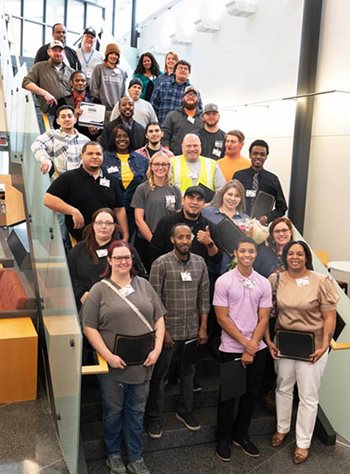 The Met Council’s commitment to help build a more equitable region showed up in a very tangible way this month as 35 people — mostly women and people of color — graduated from the fourth (and largest to date) cohort of the Building Strong Communities program.
The Met Council’s commitment to help build a more equitable region showed up in a very tangible way this month as 35 people — mostly women and people of color — graduated from the fourth (and largest to date) cohort of the Building Strong Communities program.
Building Strong Communities is the first pre-apprenticeship program for the construction trades in the state. It introduces and prepares individuals for a career in the union construction industry. Each program cohort begins and ends their journey in the spring, on time for Minnesota construction season.
Over the course of 12 weeks, participants are introduced to the industry, construction apprenticeships, and the various construction trades.
Exposing students to the realities of construction trades
“The educational piece is really critical,” explained Thomas Scott, program manager and workforce development coordinator in the Met Council’s Human Resources department. “One of the things we do is help people understand the culture of the construction trades. If people come from a retail or an office culture, they need to know construction is a whole different beast.”
For example, arriving on time at a construction site means getting there half an hour early to talk with the crew and get ready for the day. “There’s little tolerance for arriving just a few minutes before or when the actual work begins – that’s considered late,” Scott said. “And long days are not uncommon.”
“There’s a physical component to every trade – none of them are easy,” Scott added. “You will make a really good living, but it comes with hard work.” Exposing participants to the realities of the trades helps them make an informed decision about whether to move forward.
Following up with students during their apprenticeship period
Following graduation, participants choose and begin their construction apprenticeship in one of 15 participating construction trades and are supported during the first year of their apprenticeship.
“Program advocates meet with the graduates throughout that first year to answer questions and, when things get tough, help them remember why they decided to enter the trades,” Thomas said. “They may not start out operating heavy equipment – they will likely be picking up stuff around the job site. Everyone has to pay their dues. But we remind them that it will get better.”
Program is transitioning to Trade Council
The Met Council partners with the Minnesota Building and Construction Trade Council to deliver the program. Over four years, more than 70 graduates have started a union apprenticeship in 9 construction trades. Of those new apprentices, more than 70% are women and/or people of color. In the fall of 2021, the Trade Council established a labor management board to assume full ownership of the program and expand participation across the state of Minnesota.
The first half of the program is delivered virtually, which allows individuals to maintain employment during the early stages of the program. In the final weeks of the program, cohorts are required to participate in multiple day- or week-long hands-on training sessions with union trade training centers.
Graduates work on Met Council’s capital projects
The Met Council has and will continue to benefit from the program through its construction of transit and wastewater infrastructure. Met Council capital projects funded by Minnesota state funds have inclusion goals, including that more than 50% of the union labor workforce be female and/or people of color for construction contractors working on the projects. Programs like Building Strong Communities provide Met Council contractors a diverse pool of prepared individuals who want a rewarding career in the union trades. Graduates and apprentices are able to participate in building their own communities through Met Council projects while benefitting from a family-supporting career.
Construction companies that hire the program’s graduates to work on Met Council projects — like the METRO Green Line extension or wastewater infrastructure construction — receive a financial incentive based on the number of hours an apprentice works. The incentive recognizes that production drops when an experienced worker partners with an apprentice, Scott explained, and that comes at a cost to the contractor.
Hear two of the recent graduates speak in this local news story: